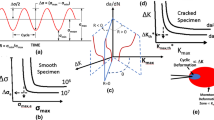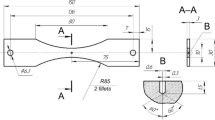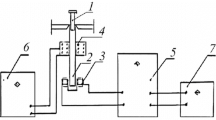Abstract
The frequency modified Coffin-Manson low cycle fatigue expression phenomenologically describes the influence of the cycling frequency on the fatigue life. This expression relates only to the fatigue life and as such does not enable the separation of the frequency influence on crack nucleation from that on propagation. The approach taken here was to study directly the propagation phase of low cycle fatigue and to this end a frequency modified crack growth expression is presented. The experiments reported here were performed on A286 (an iron-base superalloy) cycled at 1100°F with plastic strain limits. The influence of the cycling frequency is described in terms of two frequency regimes. At the lowest frequencies (below 0.05 cpm) varying the frequency did not change the time to failure. The crack growth rate is thus more a result of stress rupture than fatigue. At higher frequencies both time and cycles determine the crack propagation behavior.
Similar content being viewed by others
References
L. F. Coffin, Jr.:Fracture (1969), p. 643, Chapman and Hall Ltd., London, 1969.
L. F. Coffin, Jr.:Proc. of the Air Force Conf. on Fatigue and Fracture of Air-craft Structures and Materials, AFFDL TR 70-144, p. 301, Air Force Flight Dynamics Laboratory, Wright-Patterson AFB, Ohio, 1970.
L. F. Coffin, Jr.:Int. Conf. on Corrosion Fatigue, Storrs, Conn., June 1971, to be published by ASTM.
L. F. Coffin, Jr. and R. M. Goldhoff:1971 Int. Conf. on Mechanical Behav-ior of Materials, Kyoto Japan, Aug. 1971, to be published.
H. D. Solomon:J. Mater. 1972, vol. 7 pp. 229–306.
R. C. Boettner, C. Laird, and A. J. McEvily:Trans. TMS-AIME, 1965, vol. 233, pp. 379–87.
A. J. McEvily:Proc. of the Air Force Conf. on Fatigue and Fracture of Air-craft Structures and Materials, AFFDL TR 70-144, p. 451, Air Force Flight Dynamics Laboratory, Wright-Patterson AFB, Ohio, 1970.
T. Slot, R. H. Stentz, and J. T. Berling: Amer. Soc. Testing Mater. Special Tech. Publ. 465, p. 100, 1969.
J. F. Eckel:Proc. ASTM, 1951, vol. 51pp. 745–55.
A. Coles and D. Skinner:J. Roy. Aeronaut. Soc, 1965, vol. 69, pp. 53–54.
J. P. Gallagher and R. P. Wei:Int. Conf. on Corrosion Fatigue, Storrs, Conn. June 1971, to be published by ASTM.
R. P. Wei and J. D. Landes:Mater. Res. Standards, 1969, vol. 9, no. 7, pp. 25–28.
E. L. Robinson:Trans. ASME, 1952, vol. 74, pp. 777–81.
S. Taira:Creep in Structures, N. J. Hoff, ed., Academic Press, New York, 1962.
D. A. Spera:The 1972 Symp. on Fatigue at Elevated Temperatures, Storrs, Conn., June 1972, to be published by ASTM.
G. R. Halford and S. S. Manson:Trans. ASM, 1968, vol. 61, pp. 94–101.
S. S. Manson and G. R. Halford:Intern. Conf. on Thermal and High Strain Fatigue, Monograph and Report Ser. 32, p. 154, Metals and Metallurgy Trust, London,1967.
S. S. Manson, G. R. Halford, and D. A. Spera:The Role of Creep in High Temperature Low Cycle Fatigue Behavior of Materials, A. E. Johnson Me-morial Volume, National Eng. Lab., Glasgow, 1971.
R. D. Campbell: ASME Paper No. 71-PVP-6, 1971, to be published inTrans. ASME.
R. Lagneborg and R. Attermo:Met. Trans. 1971, vol. 2, pp. 1821–27.
H. D. Solomon and L. F. Coffin, Jr.:1972 Symp. on Fatigue at Elevated Temperatures, Storrs, Conn., June 1972, to be published by ASTM.
R. M. Goldhoff and H. J. Beattie: Extension Seminar on High Temperature Strength of Metals of the 1971 International Conference on Mechanical Behavior of Materials, Kyoto Japan, Aug. 1971, to be published.
M. J. Herdon:Acta Met., 1966, vol. 14, pp. 1173–78.
H. Shen, S. E. Podlaseck, and I. R. Kramer:Acta Met., 1966, vol. 14pp 34146.
F. J. Bradshaw and C. Wheeler:Appl. Mater. Res., 1966, vol. 5, pp. 112–20.
M. R. Achter: Amer. Soc. Testing Mater. Special Tech. Publ. 415, p. 181, 1967.
K. U. Snowden:Acta Met., 1964, vol. 12, pp. 295–303.
J. K. Tien, presentation at the 1971 AIME Meeting, Paper No. 12, October 1971, Detroit, Michigan.
J. K. Tien and R. P. Gamble:Met. Trans., 1971 vol. 2, pp. 1933–38.
T. Kondo, T. Kikiyawa, H. Kakajima, M. Shinto, and R. Nagasaki:1971 Int. Conf. on Corrosion Fatigue, Storrs, Conn., June 1971, to be published by ASTM.
Author information
Authors and Affiliations
Rights and permissions
About this article
Cite this article
Solomon, H.D. Frequency dependent low cycle fatigue crack propagation. Metall Trans 4, 341–347 (1973). https://doi.org/10.1007/BF02649635
Received:
Published:
Issue Date:
DOI: https://doi.org/10.1007/BF02649635




